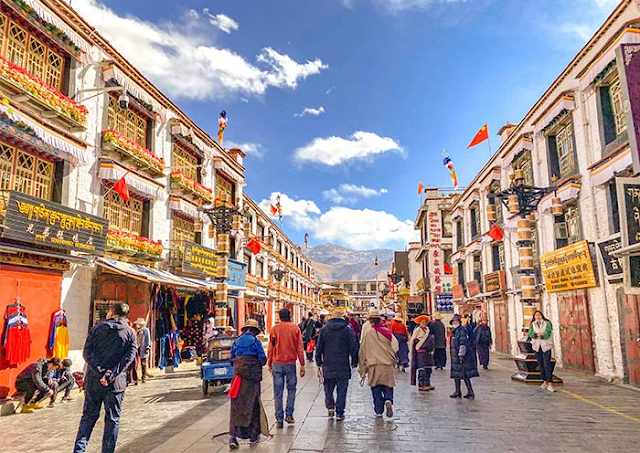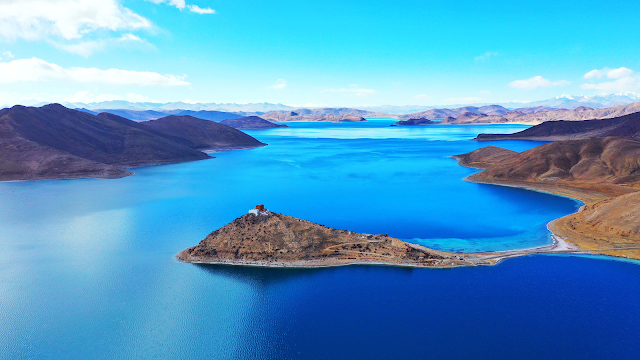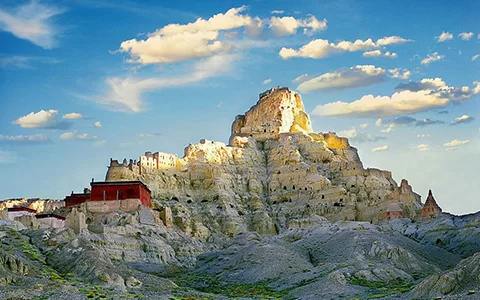Tibet, often referred to as the "Roof of the World," is an autonomous region located in the heart of the Himalayas in Asia. Known for its stunning landscapes, including towering peaks, vast plateaus, and pristine lakes, Tibet is deeply enriched with a unique blend of culture, religion, and history. It has been a center of Tibetan Buddhism for centuries, with the iconic Potala Palace in Lhasa serving as a symbol of this religious and cultural heritage. The region has a complex political history, with tensions between the Tibetan people and the Chinese government. Tibetans have strived to preserve their distinct identity, which has led to international attention and debate over issues of autonomy and human rights in the region. here are 22 tourist attractions in Tibet.
1. Potala Palace :
The Potala Palace, situated in the heart of Lhasa, Tibet, stands as a magnificent testament to the region's rich history and cultural heritage. This iconic structure, a UNESCO World Heritage Site, was originally constructed in the 7th century by King Songtsen Gampo as a palace for his brides. Later, it evolved into the winter residence of the Dalai Lamas, serving as the center of Tibetan political and religious authority for centuries. The palace's architectural grandeur is evident in its towering white and red buildings, which symbolize the fusion of Tibet's spiritual and political realms. The white part represents spirituality and is adorned with countless chapels, statues, and religious relics, while the red section represents the temporal power of the Dalai Lamas. The Potala Palace is a repository of invaluable Tibetan religious and cultural artifacts, including intricate murals, statues, manuscripts, and thangkas. As a major pilgrimage site for Buddhists and a must-visit destination for tourists, the Potala Palace continues to draw visitors from across the globe, offering a glimpse into Tibet's rich history and enduring spiritual traditions.
2. Jokhang Temple :
The Jokhang Temple, located in the heart of Lhasa, Tibet, is one of the most sacred and revered Buddhist temples in Tibet. Built in the 7th century by King Songtsen Gampo, it is considered one of the earliest Buddhist structures in Tibet and is an essential pilgrimage site for Buddhists. The temple's unique architectural style combines Tibetan, Indian, and Nepalese elements. Its main shrine houses a revered statue of Jowo Shakyamuni, the historic Buddha, which is believed to have been consecrated by the Buddha himself. The Jokhang Temple is not only a significant religious site but also an important cultural and historical landmark, showcasing the deep spiritual traditions of Tibet and attracting visitors and pilgrims from all over the world.
3. Barkhor Street :
Barkhor Street is a historic and vibrant commercial and pilgrimage circuit in the heart of Lhasa, Tibet, encircling the Jokhang Temple. It's a bustling and narrow street that has been a center of commerce and cultural activity for centuries. Barkhor Street is lined with traditional Tibetan shops, stalls, and tea houses, selling a wide range of goods, including religious artifacts, handicrafts, jewelry, and traditional clothing. It's also a significant religious route for pilgrims who walk the kora (circumambulation) around the Jokhang Temple, spinning prayer wheels and reciting prayers as they go. This area provides a rich cultural experience and offers a window into Tibetan daily life and traditions, making it a popular destination for both tourists and pilgrims.
4. Mount Everest (Sagarmatha) :
Mount Everest, standing at 8,848.86 meters (29,031.7 feet) above sea level, is the highest point on Earth and a part of the Himalayan mountain range. Located on the border between Nepal and the Tibet Autonomous Region of China, it is an iconic symbol of mountaineering and natural beauty. Climbers from around the world aspire to reach its summit, though it is a perilous and challenging endeavor due to extreme altitudes, unpredictable weather, and technical difficulties. Mount Everest is not only famous for its natural magnificence but also for its cultural and spiritual significance to the people of the region, with the mountain known as "Sagarmatha" in Nepali and "Chomolungma" in Tibetan. It draws adventurers, trekkers, and mountaineers, contributing significantly to both the local economy and our collective fascination with the world's highest peak.
5. Namtso Lake :
Namtso Lake, also known as Lake Nam, is one of the largest and highest saltwater lakes in the world. It is located in the Tibet Autonomous Region of China, at an altitude of approximately 4,718 meters (15,479 feet) above sea level. The lake is renowned for its stunning natural beauty, with clear blue waters set against a backdrop of snow-capped mountains. It holds significant spiritual and cultural importance in Tibetan Buddhism and is a popular pilgrimage site for Tibetans. The lake's serene and picturesque surroundings attract tourists and nature enthusiasts, offering opportunities for camping, hiking, and experiencing the unique landscape and wildlife of the Tibetan Plateau.
6. Yamdrok Lake :
Yamdrok Lake, often spelled Yamdrok Yumtso or Yamzho Yumco, is one of the largest and most beautiful sacred lakes in Tibet, situated at an altitude of around 4,441 meters (14,570 feet) above sea level. It is known for its stunning turquoise waters, surrounded by snow-capped mountains and lush meadows. Yamdrok Lake is not only a natural wonder but also holds cultural and spiritual significance in Tibetan Buddhism. Pilgrims and travelers visit to circumambulate the lake, perform rituals, and admire the breathtaking scenery. The lake's unique landscape and the deep blue waters make it a popular destination for tourists, offering opportunities for photography, hiking, and experiencing the serene beauty of the Tibetan Plateau.
7. Tashilhunpo Monastery :
Tashilhunpo Monastery, located in the city of Shigatse in Tibet, is one of the largest and most important monasteries in Tibetan Buddhism. Founded in 1447 by Gendun Drup, the First Dalai Lama, and expanded by his disciple, the First Panchen Lama, it has a rich history and religious significance. The monastery is known for its stunning architecture, including the awe-inspiring golden-roofed Maitreya Temple that houses a giant statue of the Future Buddha, which stands at 26.2 meters (86 feet) in height. Tashilhunpo Monastery remains an active religious center and a major pilgrimage site for Buddhists. It also attracts tourists who come to explore its spiritual and cultural heritage, as well as its historical artifacts, murals, and impressive statues.
8. Sera Monastery :
Sera Monastery, located in Lhasa, Tibet, is one of the most important and historically significant monastic institutions in Tibetan Buddhism. It was founded in the 15th century and is known for its distinctive Tibetan architectural style. Sera Monastery is famous for its debating courtyards, where monks engage in rigorous philosophical debates to sharpen their understanding of Buddhist doctrine. These debates are open to the public and draw many visitors who are fascinated by the animated and intellectual exchanges. The monastery also houses a significant collection of religious scriptures, murals, and statues, making it an essential cultural and religious landmark in Tibet.
9. Norbulingka Palace :
The Norbulingka Palace, often referred to as the "Summer Palace," is a historic palace and garden complex located in Lhasa, Tibet. Constructed in the 18th century, it served as the traditional summer residence of the Dalai Lamas, offering a peaceful retreat from the city during the warmer months. The palace features a blend of Tibetan and Chinese architectural styles and includes beautifully landscaped gardens, pavilions, and ponds. It's also known for its collection of Tibetan art and artifacts. The Norbulingka Palace is a UNESCO World Heritage Site and offers a glimpse into the cultural and historical heritage of Tibet.
10. Ganden Monastery :
Ganden Monastery is one of the most prominent and historically significant monastic institutions in Tibetan Buddhism. It's situated about 40 kilometers east of Lhasa, Tibet, on Wangbur Mountain. Founded in 1409 by Tsongkhapa, the founder of the Gelug school of Tibetan Buddhism, Ganden Monastery played a pivotal role in the development and propagation of the Gelugpa tradition. The monastery is known for its remarkable Tibetan architecture, which includes temples, prayer halls, and living quarters. One of its most iconic features is the Ganden Podrang, a palace where successive Dalai Lamas resided before the construction of the Potala Palace. Ganden Monastery continues to be a place of religious practice and study, and it attracts visitors interested in Tibetan Buddhism and its rich history.
11. Rongbuk Monastery :
Rongbuk Monastery, located in the Everest region of Tibet, is one of the highest monasteries in the world, standing at an altitude of around 5,100 meters (16,732 feet) above sea level. It is renowned for its spectacular views of Mount Everest, and it is often used as a base for trekkers and climbers heading to the Everest Base Camp. While Rongbuk Monastery is relatively small compared to other Tibetan monasteries, it holds spiritual significance for the local community and offers a unique opportunity for visitors to experience the majestic landscapes and Tibetan culture in the vicinity of the world's highest peak.
12. Yumbulagang Palace :
Yumbulagang Palace, located in the Yarlung Valley of Tibet, is considered one of the oldest and most historically significant structures in Tibet. It is believed to have been the first palace in Tibetan history and dates back over 2,000 years. Yumbulagang is perched on a hill and offers panoramic views of the surrounding valley. The palace has a unique architectural style with a mix of Tibetan and Indian elements. It has historical and cultural significance, being associated with the legendary first Tibetan king, Nyatri Tsenpo, and also considered the birthplace of Tibetan civilization. Yumbulagang Palace is a revered pilgrimage site and a symbol of Tibetan heritage, drawing both tourists and those interested in Tibet's rich history and culture.
13. Samye Monastery :
Samye Monastery, located in the Yarlung Valley of Tibet, is one of the most historic and significant monastic institutions in Tibetan Buddhism. It was founded in the 8th century and is renowned for its unique three-story mandala-style architectural design, symbolizing the Buddhist universe. Samye Monastery played a pivotal role in the early propagation of Buddhism in Tibet and the establishment of the Nyingma, Kagyu, and Sakya schools of Tibetan Buddhism. The monastery houses numerous chapels, statues, and ancient artifacts, making it an essential spiritual and cultural site in Tibet. It's also a popular destination for pilgrims and tourists alike, offering insights into Tibetan Buddhism's rich history and practices.14. Drepung Monastery :
Drepung Monastery, located on the outskirts of Lhasa, Tibet, was one of the largest and most influential monastic institutions in Tibetan Buddhism. Founded in 1416, it was closely associated with the Gelug school of Tibetan Buddhism and served as a major center for religious education and practice. At its height, Drepung Monastery housed thousands of monks and featured a complex of temples, chapels, and living quarters. The monastery is famous for its annual Shoton Festival, during which a giant thangka (religious painting) is displayed. Drepung Monastery also played a significant role in Tibetan politics, with some of the Dalai Lamas having been educated there. Today, it remains an important cultural and religious site in Tibet and attracts visitors interested in Tibetan Buddhism and history.
15. Karola Glacier :
The Karola Glacier, also known as Karola Pass or Karo La, is a glacier and mountain pass located in Tibet, China, on the Friendship Highway that connects Lhasa to Gyantse and Shigatse. The glacier is set against a stunning backdrop of the towering snow-capped mountains of the Himalayas and is known for its dramatic and picturesque scenery. The Karola Glacier is a popular stop for tourists traveling in the region, offering breathtaking views and photo opportunities. It's one of the many natural wonders that make the journey through the Tibetan plateau a remarkable experience for travelers.
16. Phabongkha Monastery :
Phabongkha Monastery, also known as Phabang Monastery or Phapang Monastery, is a Tibetan Buddhist monastery located in the eastern region of Tibet. This monastery is primarily associated with the Drukpa Kagyu school of Tibetan Buddhism, a tradition known for its unique practices and teachings. Phabongkha Monastery is renowned for its picturesque location, nestled in the mountains, and it holds cultural and spiritual significance for the local Tibetan community. While it may not be as well-known as some of the larger monastic institutions in Tibet, it plays an essential role in preserving the Drukpa Kagyu lineage and attracting visitors interested in Tibetan Buddhism and its diverse traditions.
17. Shigatse Dzong :
Shigatse Dzong, also known as Shigatse Fortress or Samdruptse Dzong, is a historical fortress and citadel located in the city of Shigatse in Tibet. It is a significant cultural and architectural landmark in the region. The fortress is strategically situated on a hill overlooking Shigatse, offering panoramic views of the city and the surrounding landscapes. While it has historical and cultural importance, Shigatse Dzong has also been renovated and transformed into a popular tourist attraction with a museum and other facilities, making it a point of interest for visitors to learn about Tibetan history and culture.
18. Pelkor Chode Monastery :
Pelkor Chode Monastery, also known as Pelkhor Monastery or Pelkor Chode Monastery, is a historic Buddhist monastery located in Gyantse, a town in the Shigatse Prefecture of Tibet, China. It's particularly renowned for its unique and harmonious coexistence of three different Tibetan Buddhist schools: Gelug, Sakyapa, and Kagyupa. The monastery complex includes various chapels, stupas, and religious artifacts, but its most distinctive feature is the Kumbum Stupa, a nine-story, multi-chapel structure that contains a vast number of religious murals and sculptures. Pelkor Chode Monastery is not only an important religious site but also a cultural and architectural gem, drawing visitors interested in Tibetan Buddhism, art, and history.
19. Tholing Monastery :
Tholing Monastery, also known as Tholing Gompa, is a historic Buddhist monastery located in the Ngari region of western Tibet, China. Founded in the 11th century by the Tibetan king Yeshe-Ö, Tholing Monastery is one of the earliest monastic institutions in Tibet and was instrumental in spreading Buddhism in the region. The monastery features a mix of Indian and Tibetan architectural styles and contains ancient murals, sculptures, and religious artifacts, making it a significant cultural and historical site. Tholing Monastery is also notable for its role in the ancient Guge Kingdom, which once thrived in the region. Today, it continues to attract visitors interested in Tibetan Buddhism and the rich heritage of western Tibet.
20. Kangrinboqe peak :
Kangrinboqe, also known as Kangrinboqê or Gang Rinpoche, is a majestic peak standing tall in the remote and sacred region of Tibet. Revered as one of the holiest mountains in the world, it holds deep spiritual significance for Buddhists and Hindus alike. Its pristine snow-covered slopes, soaring to an elevation of 6,638 meters (21,778 feet), make it a prominent pilgrimage site and a formidable challenge for mountaineers. Kangrinboqe is located near the holy Mount Kailash, adding to its spiritual aura, and its striking beauty and spiritual symbolism draw travelers and seekers from around the globe, making it an iconic and culturally rich destination in the heart of the Tibetan Plateau.
21. Gyantse Kumbum :
The Gyantse Kumbum, also known as the Gyantse Dzong or Palcho Monastery, is a remarkable architectural and religious structure located in the town of Gyantse in Tibet, China. It is a multi-storied, tiered stupa that is uniquely designed with a combination of various Tibetan Buddhist styles, including Gelug, Sakya, and Kagyu. The Kumbum contains a vast number of chapels and religious artworks, making it a significant pilgrimage site for Buddhists and a fascinating cultural site for tourists. It's one of the most iconic landmarks in Tibet and serves as a testament to the rich heritage and spiritual traditions of the region.
22. Drak Yerpa :
Drak Yerpa, also known as Druk Yerpa, is a revered cave complex and religious site located in the Yerpa Valley, about 16 kilometers northeast of Lhasa, Tibet. It is a place of deep spiritual significance in Tibetan Buddhism and is known for its numerous meditation caves and hermitages. Many famous Tibetan yogis, including Guru Rinpoche (Padmasambhava), are believed to have meditated in these caves. The site contains a variety of ancient shrines, chapels, and meditation cells, often carved into the cliffs of the valley, making it a place of pilgrimage and meditation for both monks and tourists interested in Tibetan Buddhism and its historical practices. The stunning natural beauty of the Yerpa Valley, combined with its religious importance, makes Drak Yerpa a unique and tranquil destination for visitors.
Tibet is a sought-after tourist destination due to its breathtaking natural beauty, featuring the majestic Himalayan mountain range, serene lakes, and vast plateaus. Visitors are drawn to its rich cultural heritage, which includes Tibetan Buddhism, intricate monasteries, and vibrant festivals. The unique blend of spirituality and stunning landscapes offers a profound and immersive experience for travelers, making Tibet an enticing destination for those seeking both adventure and cultural exploration.


































Comments
Post a Comment
Good days are on the way...